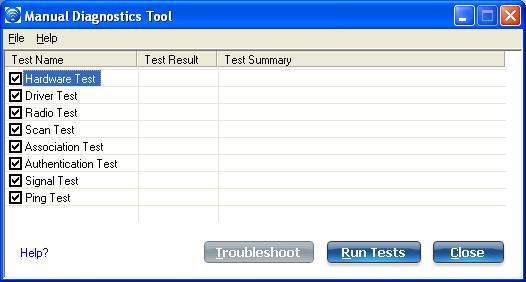
The Manual Diagnostics Tool lets you run a set of diagnostics tests that verify the functionality of your WiFi adapter. There are two levels of diagnostics details represented in this tool: user level and technical support level. At the user level, the tool only shows a short description of the different diagnostics steps that are being taken and only shows a pass or fail indication for each step.
The technical support level includes the creation of a log file which contains detailed information on all the executed tests. This log file can be saved to a text file and emailed to a technical support department to troubleshoot connection problems.

| Name | Description |
|---|---|
The test passes if the WiFi adapter is present and accessible. The test fails if the adapter is not present or present but disabled. The test summary displays whether the wireless hardware is enabled or disabled. Troubleshooting
|
|
The test summary displays the Intel® PRO/Wireless Network Connection driver supported by the WiFi adapter. The test verifies if the driver binary version is compatible with the installed version of the WiFi connection utility. The test fails if the driver binary is not found or if the driver version does not match the WiFi connection utility software version (for example, version 11.1.x.x and driver version 9.0.x.x, 9.1.x.x, or 11.1.x.x). Troubleshooting
|
|
The test summary displays Radio On or Radio Off. The test queries the current radio state. If the radio is switched on, the test passes. If the radio is off, the test fails. Troubleshooting Verify that your WiFi adapter's radio is on. Use the following methods to turn the radio on and off:
|
|
The test queries the WiFi networks within range of your WiFi adapter. The test passes if networks can be seen in the scan list. The Test Summary displays the number of networks available to connect to. Troubleshooting
|
|
The test summary displays Associated or Not Associated. Association is the establishment and maintenance of the wireless link between devices. When security is enabled, the devices only exchange security credentials. The test checks for wireless connectivity. The test passes if the client is associated successfully. Troubleshooting
|
|
Describes the process after association, during which the identity of the wireless device or end-user is verified and then allowed network access. The test queries for authentication state information, including all Cisco Compatible Extensions and security-related information. The test passes if the client is authenticated successfully. The test fails if the WEP key or other credentials are not authenticated. The Test Summary displays whether authentication is required for the network connection. Troubleshooting
|
|
The test summary displays the signal quality. If the signal quality is low, use the Troubleshoot button to diagnose and fix the problem. Troubleshooting
|
|
The test verifies whether the WiFi adapter successfully sent messages to and received replies from the access point IP address, default gateway, DHCP server (if enabled) and DNS servers. The test summary displays whether replies from these entities were received. Example: Response: AP, default gateway. No Response: DHCP server NOTE: If the ping tests to this access point and default gateway are successful but the ping test to the DNS server fails this is not a wireless network issue but a general network issue. Troubleshooting
|
|
Troubleshoot |
Diagnose and fix problems displayed by each of the tests. The Troubleshoot button becomes active if the test fails. |
Run Tests |
Executes the tests that you have selected. |
Close |
Closes the page. |
Help? |
Provides help information for this page. |